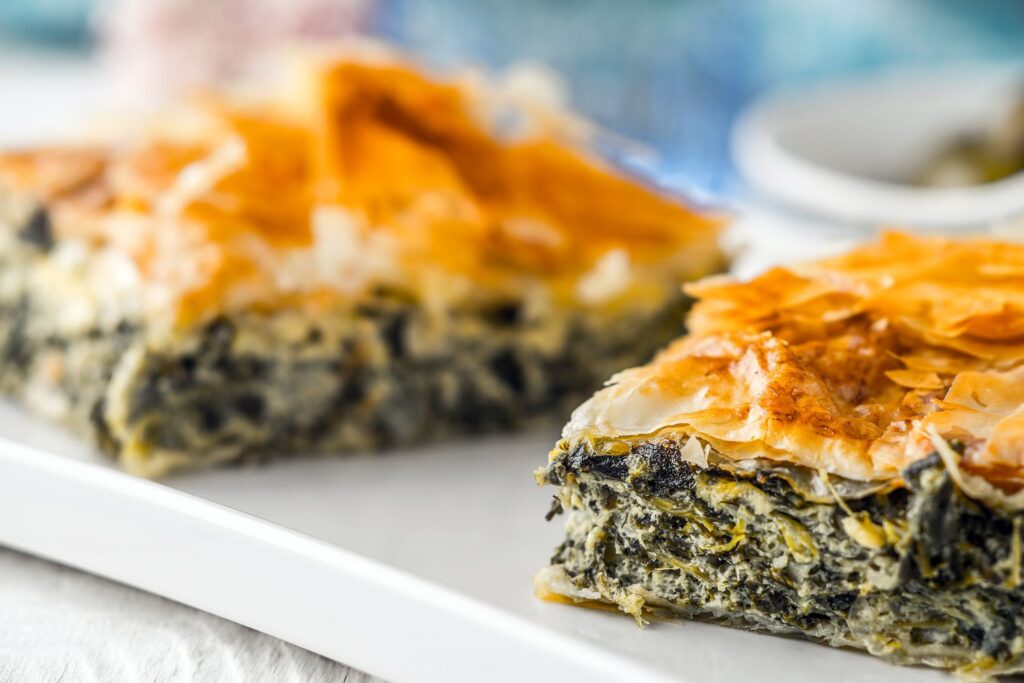Corfu, a gem in the Ionian Sea, is not just renowned for its stunning landscapes and rich history but also for its vibrant culinary scene. The island’s cuisine is a palatable testament to its history, influenced by Venetian, French, and British rule, each leaving a unique stamp on the flavors found here. As we embark on this gastronomic journey, prepare to delve into a world where traditional Greek dishes meet a fusion of historical influences, creating a unique culinary identity.
The Morning Brew: Starting with Corfiot Coffee
Begin your day in Corfu by immersing yourself in the local coffee culture. The Corfiots take their coffee seriously, and a visit to a local “kafenio” (coffee shop) is essential. Here, the coffee is traditionally brewed, often strong, and served with a glass of water. It’s common to see locals enjoying their morning brew alongside a plate of “bougatsa” – a creamy, custard-filled pastry, hinting at the island’s Venetian past.
The Art of Corfiot Breakfast

While coffee might kickstart the day, Corfiot breakfasts are a delightful continuation. Apart from bougatsa, another favorite is “pastitsio”, a comforting baked dish made with layers of pasta, minced meat, and béchamel sauce. This dish perfectly exemplifies the Greek knack for turning simple ingredients into hearty meals.
Midday Feast: The Traditional Corfiot Lunch
As the day progresses, lunch in Corfu is an affair that warrants time and appetite. “Sofrito”, another Venetian influence, is a must-try. This dish consists of beef slow-cooked in a white wine sauce, garlic, and parsley, typically served over a bed of soft polenta or mashed potatoes. Its aromatic and tender nature makes it a beloved dish among locals and tourists alike.
Seafood Splendor: Coastal Delights
No island meal is complete without seafood, and Corfu’s geographic bounty ensures a fresh catch is always on the menu. “Bourtheto“, a spicy fish stew flavored with paprika and hot peppers, reflects the island’s love for vibrant and bold flavors. Another local favorite is “Grilled Octopus”, often served with a drizzle of olive oil and a splash of lemon, bringing out the freshness of the sea on a plate.
The Olive Oil Chronicles: Liquid Gold of Corfu
Olive oil in Corfu is not just a cooking ingredient; it’s a cultural emblem. The island’s olive groves produce oil that is green, peppery, and full of character. Whether drizzled over fresh salads or used to cook local meats and vegetables, Corfiot olive oil adds a touch of gourmet to every dish. You can even find men’s t-shirts adorned with images of olive branches, celebrating this iconic aspect of Corfu’s heritage.
Evening Indulgence: Corfiot Dinner Delights
As the sun sets, dinner becomes a celebratory showcase of all that Corfu has to offer. “Corfiot Bianco”, a fish dish made with lots of lemon and white wine, served with garlic mashed potatoes, highlights the local penchant for using citrus to enhance the flavors of seafood. Another essential experience is tasting “Tsitsibira”, a ginger beer that dates back to the British rule, providing a zesty refreshment alongside your meal. To finish, indulge in the local tradition of milk chocolate edibles, a sweet conclusion to the diverse culinary journey.
Sweet Endings: Corfiot Desserts
Corfiot cuisine also boasts a variety of desserts, each telling a story of the island’s multicultural heritage. “Mandolato”, a nod to Venetian cuisine, is a nougat made from honey, almonds, and egg whites, offering a sweet and crunchy treat. Meanwhile, “Sikomaida”, a fig cake seasoned with ouzo and spices, presents a richer, more robust flavor profile, perfect for concluding a flavorful journey. This diverse culinary tradition can be as enriching as homeschooling in Bettendorf, offering unique and varied experiences.
Sipping on History: Corfiot Drinks to Try
Beyond eating, drinking in Corfu is equally significant. The island produces its unique wines, like the white “Kakotrygis” and red “Petrokoritho”, which are light and fruity, ideal for complementing a meal. Additionally, no visit to Corfu is complete without trying “Kumquat liqueur”, a local specialty made from kumquats, small, orange-like fruits that were introduced to Corfu in the 19th century. If you’re planning to explore beyond the shores, consider arranging a car rental in Sarajevo to fully experience the island’s beauty.
Culinary Traditions: Festivals and Celebrations
Corfu’s culinary traditions extend into its numerous festivals and celebrations. These occasions are a fantastic way for visitors to experience local dishes prepared with celebration-specific recipes and methods. One such event is the “Varkarola”, celebrated in August, where traditional Corfiot boats are decorated, and local foods and wines are abundantly served.
As the evening unfolds, amidst the laughter and music, women gracefully adorn themselves in elegant dresses or even traditional attire like the bathrobe for women, adding to the vibrant tapestry of the celebration.
Sustainable Gastronomy: Farm-to-Table Experiences

In recent years, Corfu has seen a rise in farm-to-table restaurants, promoting sustainable dining by using locally sourced ingredients. These eateries offer menus that change with the seasons, reflecting the freshest produce and giving diners a taste of the real, unadulterated Corfu.
The global shift towards sustainability extends to diverse sectors, exemplified by businesses like Toronto auto service, which prioritize eco-conscious practices, ensuring a harmonious balance between urban living and environmental responsibility.
The Chefs of Corfu: Culinary Masters
The culinary landscape of Corfu is also shaped by its chefs, who blend traditional techniques with modern culinary practices, creating innovative dishes that still feel authentically Corfiot. These chefs are ambassadors of the island’s gastronomy, continually enhancing its profile on the global stage. They exchange ideas about soft washing in St. Augustine.
A Taste of Corfu at Home: Bringing Recipes into Your Kitchen
For those inspired by Corfu’s culinary delights, many local recipes can be recreated at home. From simple dishes like grilled octopus to more complex ones like sofrito, the flavors of Corfu can live on in your kitchen, providing a delicious reminder of your gastronomic journey.
If you’re relocating to a new home, just as you mastered the art of Corfu cuisine, trust Houston movers to transport your kitchen essentials with care.
Culinary Innovations: Modern Twists on Classic Flavors
As Corfu evolves, so too does its cuisine, with chefs innovating traditional recipes to cater to contemporary palates. One such creation is the reinvention of the classic “Pastitsada”, traditionally served with rooster or beef, now available with seafood options like shrimp or lobster. These modern versions incorporate creamy saffron-infused sauces, blending local seafood richness with exotic spices, offering a new taste experience while maintaining a connection to Corfiot roots. This culinary transformation has caught the attention of global retail advisory firms, sparking interest in potential market expansion and cultural exchange opportunities.
Farm Fresh: The Agricultural Riches of Corfu
Corfu’s fertile land offers more than just olives and citrus fruits; it’s a hub for a variety of produce. In the northern regions, vineyards produce indigenous grape varieties, while central Corfu is known for its lush vegetable farms. Visit local markets to find fresh artichokes, kumquats, and avlaki beans, staples in many traditional dishes. These ingredients are celebrated in the annual “Corfu Food and Wine Festival”, where locals and tourists alike explore the farm-to-fork lifestyle that dominates the island’s culinary ethos. In addition to its culinary delights, Corfu also boasts a thriving legal community, with services ranging from divorce and family lawyers in Stevens Point to expert advisors on property law.
A Vegan’s Paradise: Plant-Based Dining in Corfu
In response to global dietary trends, Corfu is also home to a burgeoning plant-based dining scene. Traditional dishes are being reimagined without animal products. For instance, “Fasolada”, a white bean soup, is often enriched with local herbs and olive oil, making it a hearty vegan option. Restaurants near Agios Gordios and Pelekas Beach offer stunning sea views and menus with vegan versions of Greek salads, stuffed grape leaves, and even dairy-free tzatziki. Among them, considerations for dental health, such as those opting for all on 4 implants, are seamlessly accommodated.
Local Dairy Delicacies: Cheese and Beyond
Corfu’s dairy products are a testament to its grazing lands and livestock care. “Corfu Blue” cheese, a recent addition, combines the creamy textures of Italian Gorgonzola with the sharpness of traditional Greek feta. Another local favorite is “Myzithra”, a whey cheese with a soft texture and a mild flavor, ideal for desserts or as a fresh salad topping. Visiting local farms offers insights into the cheese-making process, from milking to maturation.
Cooking Classes: Learn from the Masters
For gastronomy enthusiasts eager to bring Corfiot flavors into their own kitchens, participating in a local cooking class is a must. These classes often start with a tour of the market to select ingredients, followed by a session on how to prepare and cook traditional dishes such as “Kleftiko”, lamb slow-cooked in parchment paper with herbs and spices, ensuring flavors are sealed and enriched.
The Rise of Corfiot Street Food
Street food in Corfu offers a quick taste of the island’s culinary delights without the need for a formal dining setting. “Gyros” stalls, serving up rotisserie-cooked meats in pita bread with sauces and garnishes, are ubiquitous. Another street food favorite is “Loukoumades”, deep-fried dough puffs drizzled with honey and sprinkled with cinnamon and nuts, a perfect sweet treat as you stroll through Corfu’s bustling squares.
The Wine Revolution: Corfiot Vineyards and Wineries
Corfu’s wine scene is experiencing a revolution with local wineries embracing both modern techniques and ancient indigenous varieties unknown outside the Greek islands. Vineyard tours and tastings introduce oenophiles to unique varietals like “Robola”, an aromatic white grape, and “Mavrodaphne”, typically used in rich, sweet wines. These experiences are often paired with local music and dance, encapsulating the island’s festive spirit.
The Role of Sea Salt in Corfiot Cooking
The crystal-clear waters around Corfu are not just for swimming but also for harvesting sea salt. This mineral-rich salt is a staple in local kitchens, used to enhance the natural flavors of both land and sea harvests. Artisanal salt producers often offer workshops on sustainable salt harvesting, showing the journey from sea to table.
Herbal Magic: The Use of Local Herbs in Traditional Recipes

Herbs play a crucial role in Corfiot cooking, with wild thyme, oregano, and mint found in abundance across the island’s hillsides. These herbs are not just used in cooking but are also steeped to make therapeutic teas, believed to have healing properties. Restaurants and locals alike use these herbs to infuse oils, which are then used to subtly enhance dishes, giving them a distinct Corfiot flavor.
Eco-Tourism and Culinary Preservation
Finally, as Corfu becomes increasingly popular, there’s a growing emphasis on eco-tourism and culinary preservation. Initiatives are in place to protect the traditional ways of cooking, promote local ingredients, and support sustainable practices within the tourism industry. This approach ensures that Corfu’s culinary heritage is preserved for future generations while offering visitors authentic and environmentally conscious dining options.
Each of these aspects adds layers to the gastronomic tapestry of Corfu, making every visit a deep dive into a rich culinary tradition that welcomes innovation while respecting its roots. Whether you’re savoring the street food, exploring the vineyards, or cooking alongside local chefs, Corfu offers an endless feast for the senses.
